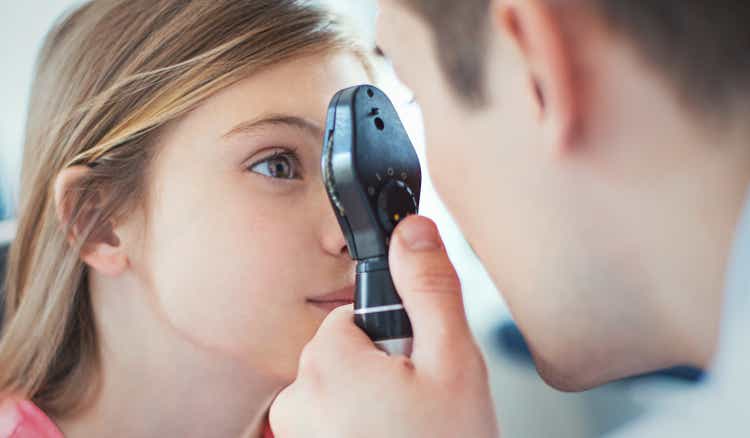gilaxia/E+ via Getty Images
Regeneron (NASDAQ:REGN) reported strong Q3 results, beating EPS and revenue estimates. The key update I was looking for is how Eylea fared in the quarter considering the very strong launch of Vabysmo. I continue to see Eylea as a cash flow machine with a declining contribution to Regeneron’s total sales in the following years considering its very high branded market share and the increasing competition, but it was nice to see that sales held up well despite Roche (OTCQX:RHHBY) reporting excellent sales of Vabysmo in the quarter. And Regeneron should also be armed with the high-dose Eylea in the second half of 2023 which should help prevent some of the erosion in the following years.
The rest of the product portfolio performed well and Libtayo recently secured FDA approval in combination with chemotherapy as a first-line treatment for advanced non-small cell lung cancer and European Commission approval for cervical cancer and this should improve its trajectory in 2023 and beyond.
Eylea holds up well in Q3 but pressure from Vabysmo to increase in Q4
Eylea’s net sales in the United States grew 11% Y/Y to $1.63 billion. This was a slight deceleration from 13% and 14% Y/Y growth in the previous two quarters, but a decent result.
Vabysmo generated CHF150 million ($152 million) in U.S. net sales in the third quarter and Roche says that the primary sources of demand are Eylea switches and new patient starts.
It was interesting to see comments from both management teams. Roche claimed market share gains over Eylea while Regeneron said that Eylea captured growth primarily from Lucentis and Avastin, and they also said that “if you put the Roche portfolio together, the growth of Eylea obviously was positive while there was a decline in a real market share for the Roche products combined.”
I should note that both Lucentis and Avastin are Roche’s old products and that both had global net sales declines of 25% and 29% Y/Y, respectively, with Lucentis’ decline primarily coming from the United States, and Roche admitted during the Q&A session that the erosion is also partly due to Vabysmo cannibalization.
So, it is an interesting dynamic that is going to change somewhat going forward. The permanent J-code for Vabysmo as of early October should help smooth and accelerate the reimbursement process going forward, and Regeneron is working to get the high dose Eylea (8mg aflibercept) to market as fast as possible.
The company recently reported positive phase 3 results of 8mg aflibercept in both wet AMD and diabetic macular edema and the new biologics license application is expected before the end of the year. Regeneron plans to use a Priority Review Voucher to shorten the review period to six months. If all goes well, 8mg aflibercept should reach the U.S. market in mid-2023.
8mg aflibercept is critical for Regeneron’s long-term plans of maintaining its leadership position. 93% of diabetic macular edema patients in the PHOTON study maintained 12-week or longer dosing intervals, and 83% of wet AMD patients did the same in the PULSAR trial.
Overall, I continue to believe it will be hard for Eylea to continue to deliver as strong growth rates as it did in prior years, and that sales could start to erode as soon as next year, but that Eylea should remain a considerable cash flow machine for Regeneron in the following years.
Dupixent continues to deliver, Libtayo’s growth to accelerate after recent approvals
Dupixent delivered another very strong quarter. Global net sales grew 40% Y/Y to $2.33 billion and Regeneron’s share of antibody profits rose 42% Y/Y to $551 million. Dupixent has a lot of room to grow and net sales will likely exceed $10 billion in 2023, and the recent approval for prurigo nodularis should provide another sales boost in the following quarters.
There are also two important readouts for Dupixent in the first half of 2023 – phase 3 results in patients with chronic inducible cold urticaria and chronic obstructive pulmonary disease (‘COPD’).
Global sales of Libtayo grew 20% Y/Y to $143 million in the third quarter, but the more important events for the product were the early November FDA approval in combination with chemotherapy for the treatment of first-line non-small cell lung cancer and this week’s European Commission approval as the first immunotherapy in second-line recurrent or metastatic cervical cancer irrespective of PD-L1 expression level or tumor histology. The expanded labels in the U.S. and Europe should lead to growth acceleration in 2023.
Conclusion
Regeneron’s long-term outlook has incrementally improved since my previous update thanks to the clinical de-risking of high-dose Eylea and the approvals of Libtayo in the United States and Europe, but the 25% increase in the company’s valuation reflects these improvements.
The pipeline should continue to produce important pivotal data in the following quarters, and they could lead to label expansion for Dupixent and Libtayo, and the product portfolio could receive valuable additions in hematologic malignancies in 2024 given the planned regulatory submissions next year for odronextamab for the treatment of follicular lymphoma and diffuse large B-cell lymphoma, and linvoseltamab for the treatment of multiple myeloma.
The company also continues to invest heavily in its internal pipeline and has started to increasingly look for tuck-in acquisitions and in-licensing deals, the most recent being with CytomX (CTMX) this month. We should see many additional deals going forward given the $13 billion in cash position at the end of Q3 and an average of nearly $1 billion in quarterly cash flow this year.


Be the first to comment